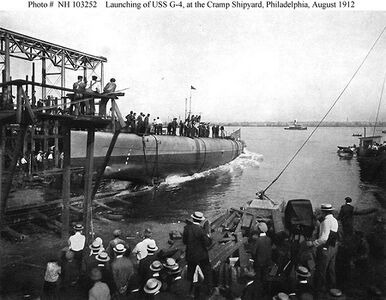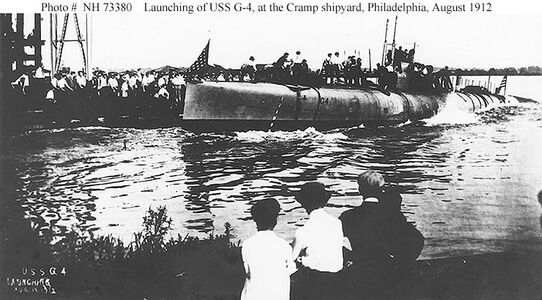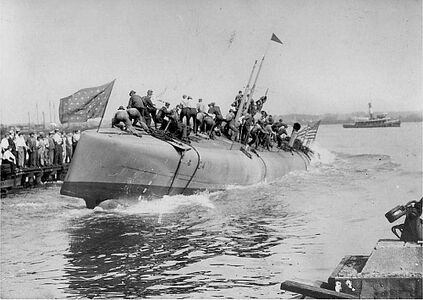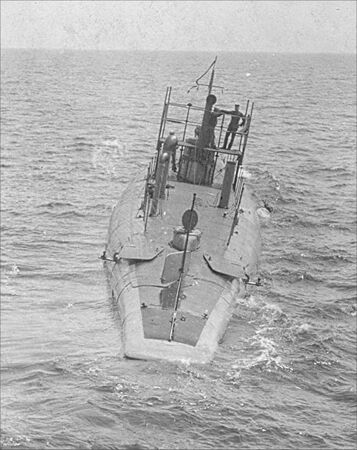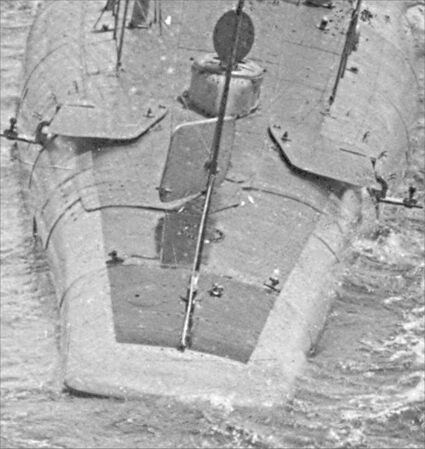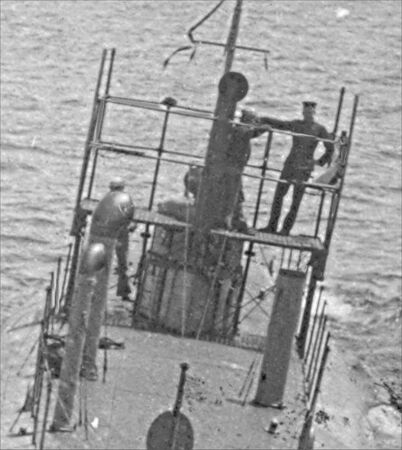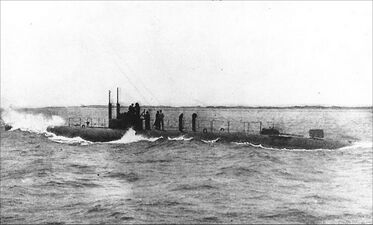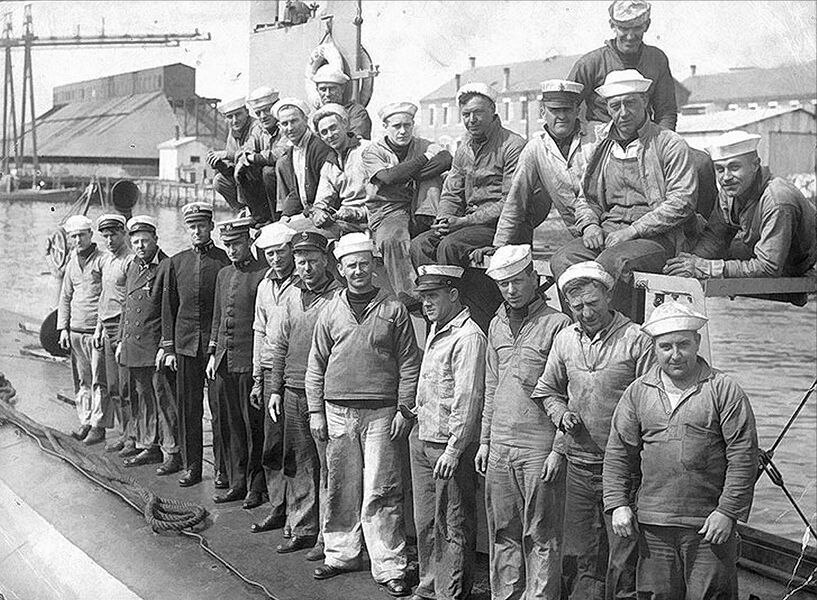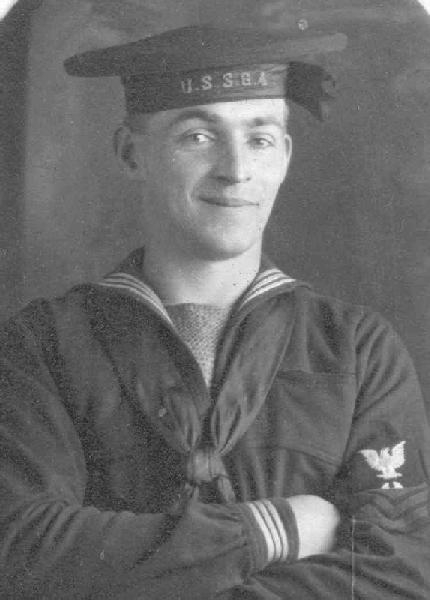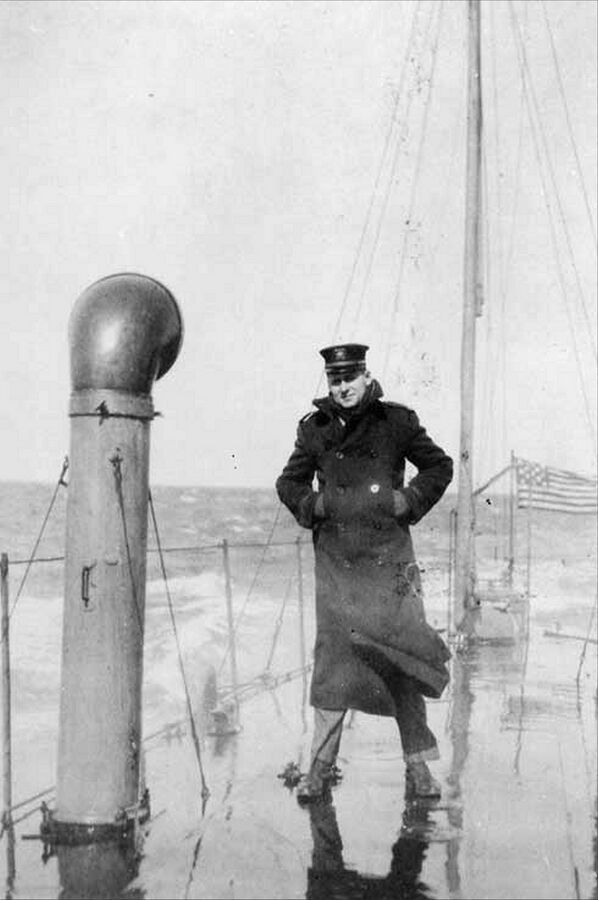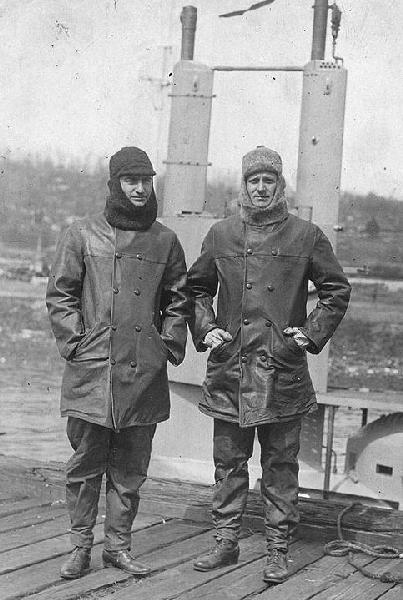G-4: Difference between revisions
Pbcjohnston (talk | contribs) (Added gallery 2) |
Pbcjohnston (talk | contribs) (Re-arranged the diagrams at top of page and moved the Laurenti drawing from the blueprints page) |
||
| (9 intermediate revisions by the same user not shown) | |||
| Line 1: | Line 1: | ||
[[File:G-Boat Header 2.jpg|center]] | [[File:G-Boat Header 2.jpg|center]] | ||
[[File: | <br> | ||
[[File:g-4 lines-2.jpg|left|600px]] | |||
[[File:G-4_diagram.jpg|left|600px]] | |||
<div style="text-align: justify;"><span style="color:#00008B">G-4 was an attempt to introduce competition to the submarine acquisition process in the years immediately before WWI. Authorized in Fiscal Year 1910 along with Lake's Turbot, Thrasher was built to an Italian design by naval architect Cesare Laurenti, whose engineering work for the Italian Navy had gained some recognition. The top diagram shows the original design by Laurenti, and it had significant differences from the boat that was actually built for the USN, as shown in the second diagram. The biggest differences are in the arrangement of the battery wells, the engines, and the aft torpedo tubes. The first drawing shows the Laurenti design with the after battery all the way in the stern, ''aft'' of the engines, which would prevent the placement of aft torpedo tubes. It also shows at least two extra engines and hatches in different locations. Whether these significant changes in the G-4's internal arrangement reflect a maturation of the Laurenti design, or if they were made at the insistence of the USN before the boat would be built is not known at this time. | |||
Laurenti contracted with the William Cramp & Sons Shipbuilding Co. in Philadelphia for construction. The design as built had two forward 18" torpedo tubes that were situated ''below'' the elongated bow, with two more aft under an overhanging flat "shovel" shaped stern. These aft tubes were the very first aft firing tubes in a USN submarine. She was a double hull boat, with an inner elliptically shaped pressure hull wrapped by a flattened circle shaped outer hull. Two fixed height periscopes were fitted forward of the conning tower. She also had two rudders, one below the stern and a smaller one topside on the aft deck. G-4 (Thrasher) suffered from numerous mechanical and stability problems and was not considered successful, despite being liked by her crews. She was the only submarine built to a foreign design ever commissioned into the USN. | |||
<small>Drawing by Jim Christley, courtesy of Navsource.org</small> | |||
[[File:Red bar sub new 2.jpg]] | [[File:Red bar sub new 2.jpg]] | ||
<gallery mode=packed widths=300 heights=200> | <gallery mode=packed widths=300 heights=200> | ||
File:G4-g4launch3-04.jpg|<div style="text-align: justify;"><span style="color:#00008B">G-4 sliding down the ways at the Cramp yard, August 15, 1912. The strange looking bulge seen on the under-body of the bow just to the right of the diagonal brace is the port torpedo tube. Photo NH 103252 courtesy NHHC</span> | File:G4-g4launch3-04.jpg|<div style="text-align: justify;"><span style="color:#00008B">G-4 sliding down the ways at the Cramp yard, August 15, 1912. The strange looking bulge seen on the under-body of the bow just to the right of the diagonal brace is the port torpedo tube. Photo NH 103252 courtesy NHHC</span> | ||
File:G4-g4launch31-05.jpg|<div style="text-align: justify;"><span style="color:#00008B">This photo was taken a few seconds after the one on the left. The stern has become buoyant and is lifting off the launch cradle. She is starting to lean to port. Photo NH 73380 courtesy of NHHC.</span> | File:G4-g4launch31-05.jpg|<div style="text-align: justify;"><span style="color:#00008B">This photo was taken a few seconds after the one on the left. The stern has become buoyant and is lifting off the launch cradle. She is starting to lean to port, most likely do to improperly calculated buoyancy. Photo NH 73380 courtesy of NHHC.</span> | ||
File:G4-g4launch32-06.jpg|<div style="text-align: justify;"><span style="color:#00008B">Now with only her bow on the launch cradle, G-4 lists heavily to port. The yard workers topside are scrambling to the starboard side in an attempt to stay aboard. A near disaster was averted and to | File:G4-g4launch32-06.jpg|<div style="text-align: justify;"><span style="color:#00008B">Now with only her bow on the launch cradle, G-4 lists heavily to port. The yard workers topside are scrambling to the starboard side in an attempt to stay aboard. A near disaster was averted and the G-4 eventually floated upright, but we have uncovered anecdotal evidence to suggest several people went over the side and got wet. National Archives photo.</span> | ||
</gallery> | </gallery> | ||
[[File:Red bar sub new 2.jpg]] | [[File:Red bar sub new 2.jpg]] | ||
[[File:G4-g4top-07.jpg|left| | [[File:G4-g4top-07.jpg|left|500px]] | ||
<div style="text-align: justify;"><span style="color:#00008B">G-4 at the Cramp yard during her 'fitting out' period, fall of 1912. This is a good overhead view of some of her more unusual features. The bow planes lay flat on the fore deck. They fold out and down and lock on to an axle that then rotates the planes to dive and rise positions. Although hard to see at the stern, the stern planes operate like the bow planes and are partly extended. The port plane can be seen as a square shape just forward of the 'doghouse' on the stern. The starboard plane is actually seen edge on, but its reflection can be seen in the water and you can se its square shape there. In the fully extended position both sets of planes would be flat to the water. Cramp yard slipways can be seen in the background.</ | <div style="text-align: justify;"><span style="color:#00008B">G-4 at the Cramp yard during her 'fitting out' period, fall of 1912. This is a good overhead view of some of her more unusual features. The bow planes lay flat on the fore deck. They fold out and down and lock on to an axle that then rotates the planes to dive and rise positions. Although hard to see at the stern, the stern planes operate like the bow planes and are partly extended. The port plane can be seen as a square shape just forward of the 'doghouse' on the stern. The starboard plane is actually seen edge on, but its reflection can be seen in the water and you can se its square shape there. In the fully extended position both sets of planes would be flat to the water. Cramp yard slipways can be seen in the background. | ||
<small>National Archives photo.</small> | |||
[[File:Red bar sub new 2.jpg]] | [[File:Red bar sub new 2.jpg]] | ||
[[File:G-4_fittingout.jpg|left| | [[File:G-4_fittingout.jpg|left|500px]] | ||
<div style="text-align: justify;"><span style="color:#00008B">G-4, seen on October 2, 1912, at the Cramp yard going through her 'fitting out' period where she will receive a majority of her piping, electrical and internal systems and habitability features. On the right near the bow the anchor hawsepipe can be seen, with an anchor chain running aft into an enclosed locker. This locker housed the anchor itself, attached to a "billboard" style release mechanism. The locker doors had to be opened to release the anchor. Billboard style anchor mounts were common on surface ships of this time, but very unusual on submarines.</ | <div style="text-align: justify;"><span style="color:#00008B">G-4, seen on October 2, 1912, at the Cramp yard going through her 'fitting out' period where she will receive a majority of her piping, electrical and internal systems and habitability features. On the right near the bow the anchor hawsepipe can be seen, with an anchor chain running aft into an enclosed locker. This locker housed the anchor itself, attached to a "billboard" style release mechanism. The locker doors had to be opened to release the anchor. Billboard style anchor mounts were common on surface ships of this time, but very unusual on submarines. | ||
<small>Photo NH 43799 courtesy of the Naval History & Heritage Command.</small> | |||
[[File:Red bar sub new 2.jpg]] | [[File:Red bar sub new 2.jpg]] | ||
<gallery mode=packed widths=400 heights=300> | <gallery mode=packed widths=400 heights=300> | ||
File:G4-g4atsea-11.jpg|<div style="text-align: justify;"><span style="color:#00008B">G-4 at sea prior to WW I, approximately 1914. The position of the upper rudder says that the submarine is making a left turn, and this could explain the starboard list | File:G4-g4atsea-11.jpg|<div style="text-align: justify;"><span style="color:#00008B">G-4 at sea prior to WW I, approximately 1914. The position of the upper rudder says that the submarine is making a left turn, and this could explain the starboard list.</span> | ||
File:G4-g4atsea2-12.jpg|<div style="text-align: justify;"><span style="color:#00008B">Closeup of the stern, showing details of the topside rudder, folded up stern planes, and the open aft torpedo room hatch.</span> | File:G4-g4atsea2-12.jpg|<div style="text-align: justify;"><span style="color:#00008B">Closeup of the stern, showing details of the topside rudder, folded up stern planes, and the open aft torpedo room hatch.</span> | ||
File:G4-g4atsea3-13.jpg|<div style="text-align: justify;"><span style="color:#00008B">Closeup of the conning tower fairwater and bridge structure. The commissioning pennant is flying from the radio mast. The officer on the right is most likely the boat's Commanding Officer, LT Ernest D. McWhorter, a Navy Cross awardee later in WWI.</span> | File:G4-g4atsea3-13.jpg|<div style="text-align: justify;"><span style="color:#00008B">Closeup of the conning tower fairwater and bridge structure. The commissioning pennant is flying from the radio mast. The officer on the right is most likely the boat's Commanding Officer, LT Ernest D. McWhorter, a Navy Cross awardee later in WWI.</span> | ||
</gallery> | </gallery> | ||
<small> Photo from the Rick Larson Collection, now in the private collection of Ric Hedman.</small> | |||
[[File:Red bar sub new 2.jpg]] | [[File:Red bar sub new 2.jpg]] | ||
<gallery mode=packed widths=250 heights=150> | <gallery mode=packed widths=250 heights=150> | ||
File:G4-g4atsea-09.jpg|<div style="text-align: justify;"><span style="color:#00008B">G-4 at sea, most likely pre-WW I, circa 1914-15. Note the Allied signal bell on the fore deck aft of the hatch and the upper rudder all the way to the right, behind the two men.</span> | File:G4-g4atsea-09.jpg|<div style="text-align: justify;"><span style="color:#00008B">G-4 at sea, most likely pre-WW I, circa 1914-15. Note the Allied signal bell on the fore deck aft of the hatch and the upper rudder all the way to the right, behind the two men.</span> | ||
File:G4-g4atsea2-10.jpg|<div style="text-align: justify;"><span style="color:#00008B">G-4 at sea, burying her bow in a head sea, most likely pre-WW I, circa 1914-15. The upper rudder can be clearly seen in this photo.</span> | File:G4-g4atsea2-10.jpg|<div style="text-align: justify;"><span style="color:#00008B">G-4 at sea, burying her bow in a head sea, most likely pre-WW I, circa 1914-15. The upper rudder can be clearly seen in this photo.</span> | ||
</gallery> | </gallery> | ||
<small>National Archives photos.</small> | |||
[[File:Red bar sub new 2.jpg]] | [[File:Red bar sub new 2.jpg]] | ||
[[File:G4-g4workers10301912-08.jpg|left| | [[File:G4-g4workers10301912-08.jpg|left|500px]] | ||
<div style="text-align: justify;"><span style="color:#00008B">A few of the workmen from the Cramp ship yard that built the G-4. Seen here are yard officials, shop and department supervisors and the craftsmen who were putting the G-4 together. Commissioning was still 14 months away.</ | <div style="text-align: justify;"><span style="color:#00008B">A few of the workmen from the Cramp ship yard that built the G-4. Seen here are yard officials, shop and department supervisors and the craftsmen who were putting the G-4 together. Commissioning was still 14 months away. | ||
<small>Photo NH 73381 courtesy NHHC.</small> | |||
[[File:Red bar sub new 2.jpg]] | [[File:Red bar sub new 2.jpg]] | ||
<gallery mode=packed widths=500 heights=400> | |||
<div style="text-align: justify;"><span style="color:#00008B">Ship's officers and crew posed on deck, 1917. She was then operating out of Submarine Base New London, CT. The two officers (4th & 5th from left, front row) are Lieutenant (Junior Grade) Paul F. Foster (Commanding Officer) and Lieutenant (Junior Grade) William F. Callaway (Executive Officer).</span> | File:G4-g4crew1917-14.jpg|<div style="text-align: justify;"><span style="color:#00008B">Ship's officers and crew posed on deck, 1917. She was then operating out of Submarine Base New London, CT. The two officers (4th & 5th from left, front row) are Lieutenant (Junior Grade) Paul F. Foster (Commanding Officer) and Lieutenant (Junior Grade) William F. Callaway (Executive Officer). <small>National Archives photo.</small></span> | ||
File:G4-g4a-17.jpg|<div style="text-align: justify;"><span style="color:#00008B">A G-4 crewman whose name has unfortunately been lost to the ages. He is in his dress blues, wearing the traditional "flat hat" with the G-4 name on it. The rate insignia on his left arm is unclear, but it may be for a Machinist Mate or Motor Machinist Mate 1st Class.</span> | |||
</gallery> | |||
[[File:Red bar sub new 2.jpg]] | [[File:Red bar sub new 2.jpg]] | ||
[[File:Crew-enspaulwfoster-001.jpg|left|500px]] | |||
[[File:Crew-enspaulwfoster-001.jpg|left| | <div style="text-align: justify;"><span style="color:#00008B">Ensign Paul Frederick Foster, USN, photographed circa 1914. Foster was born on March 25, 1889 in Wichita, Kansas. He received a senatorial appointment from the State of Idaho to the U.S. Naval Academy. Following graduation in 1911, he served on the cruiser USS Washington (Armored Cruiser No. 11) and the battleship USS Utah (BB-31) as a midshipman and, in March 1912, was commissioned as an Ensign. On 21-22 April 1914, Foster participated at the intervention at Vera Cruz, Mexico, leading his landing company with skill and courage. For his "distinguished conduct in battle", he was awarded the Medal of Honor. | ||
<div style="text-align: justify;"><span style="color:#00008B">Ensign Paul Frederick Foster, USN, photographed circa 1914. Foster was born on March 25, 1889 in Wichita, Kansas. He received a senatorial appointment from the State of Idaho to the U.S. Naval Academy. Following graduation in 1911, he served on the cruiser USS Washington (Armored Cruiser No. 11) and the battleship USS Utah (BB-31) as a midshipman and, in March 1912, was commissioned as an Ensign. On 21-22 April 1914, Foster participated at the intervention at Vera Cruz, Mexico, leading his landing company with skill and courage. For his "distinguished conduct in battle", he was awarded the Medal of Honor.</span | |||
After submarine instruction on board the auxiliary cruiser USS Prairie, he reported on board the G-4. In March 1915, Foster was promoted to Lieutenant Junior Grade and, in early 1916, was given command of G-4. | |||
Relocating to Ireland in December 1917, he was assigned to the submarine tender USS Bushnell (Submarine Tender No. 2) in Bantry Bay, Ireland. Foster was temporarily promoted to Lieutenant in May 1918. While serving in Irish waters, he took command of the submarine L-2 (Submarine No 41). Lieutenant Foster was awarded the Distinguished Service Medal for his role in the sinking of the German submarine UB-65 off the Irish coast on 10 July 1918.</span><br> | |||
< | <small>National Archives photo.</small> | ||
[[File:Red bar sub new 2.jpg]] | [[File:Red bar sub new 2.jpg]] | ||
<gallery mode=packed widths= | |||
File:G4-g4foster-15.jpg|<div style="text-align: justify;"><span style="color:#00008B">Photographed on board the submarine G-4, commanding officer Lieutenant (Junior Grade) Paul F. Foster, circa 1915-1916. G-4 looks to be a wet boat on the surface | <gallery mode=packed widths=500 heights=600> | ||
File:6a-g-4.jpg|<div style="text-align: justify;"><span style="color:#00008B">G-4's officers standing beside their submarine, at Submarine Base New London, CT. in 1917. They are Lieutenant (Junior Grade) William F. Callaway (Executive Officer), at left, and Lieutenant (Junior Grade) Paul F. Foster (Commanding Officer) | File:G4-g4foster-15.jpg|<div style="text-align: justify;"><span style="color:#00008B">Photographed on board the submarine G-4, commanding officer Lieutenant (Junior Grade) Paul F. Foster, circa 1915-1916. G-4 looks to be a wet boat on the surface.</span> | ||
File:6a-g-4.jpg|<div style="text-align: justify;"><span style="color:#00008B">G-4's officers standing beside their submarine, at Submarine Base New London, CT. in 1917. They are Lieutenant (Junior Grade) William F. Callaway (Executive Officer), at left, and Lieutenant (Junior Grade) Paul F. Foster (Commanding Officer).</span> | |||
</gallery> | </gallery> | ||
<small>National Archives photos.</small> | |||
[[File:Red bar sub new 2.jpg]] | [[File:Red bar sub new 2.jpg]] | ||
<center>[[G-class|Return to the G-class page]] | [[Submarine Classes|Return to the Submarine Classes page]]</center> | |||
[[File:Red bar sub new.jpg]] | |||
<center> | <center> | ||
Page created by:<br> | Page created by:<br> | ||
Latest revision as of 15:33, 4 March 2024



Laurenti contracted with the William Cramp & Sons Shipbuilding Co. in Philadelphia for construction. The design as built had two forward 18" torpedo tubes that were situated below the elongated bow, with two more aft under an overhanging flat "shovel" shaped stern. These aft tubes were the very first aft firing tubes in a USN submarine. She was a double hull boat, with an inner elliptically shaped pressure hull wrapped by a flattened circle shaped outer hull. Two fixed height periscopes were fitted forward of the conning tower. She also had two rudders, one below the stern and a smaller one topside on the aft deck. G-4 (Thrasher) suffered from numerous mechanical and stability problems and was not considered successful, despite being liked by her crews. She was the only submarine built to a foreign design ever commissioned into the USN.
Drawing by Jim Christley, courtesy of Navsource.org
-
G-4 sliding down the ways at the Cramp yard, August 15, 1912. The strange looking bulge seen on the under-body of the bow just to the right of the diagonal brace is the port torpedo tube. Photo NH 103252 courtesy NHHC
-
This photo was taken a few seconds after the one on the left. The stern has become buoyant and is lifting off the launch cradle. She is starting to lean to port, most likely do to improperly calculated buoyancy. Photo NH 73380 courtesy of NHHC.
-
Now with only her bow on the launch cradle, G-4 lists heavily to port. The yard workers topside are scrambling to the starboard side in an attempt to stay aboard. A near disaster was averted and the G-4 eventually floated upright, but we have uncovered anecdotal evidence to suggest several people went over the side and got wet. National Archives photo.
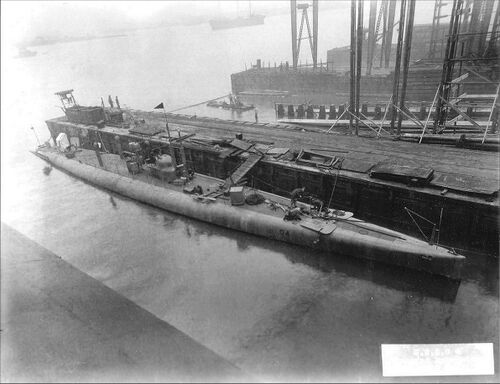
National Archives photo.
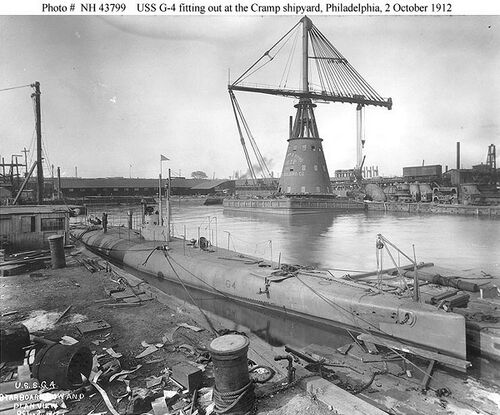
Photo NH 43799 courtesy of the Naval History & Heritage Command.
-
G-4 at sea prior to WW I, approximately 1914. The position of the upper rudder says that the submarine is making a left turn, and this could explain the starboard list.
-
Closeup of the stern, showing details of the topside rudder, folded up stern planes, and the open aft torpedo room hatch.
-
Closeup of the conning tower fairwater and bridge structure. The commissioning pennant is flying from the radio mast. The officer on the right is most likely the boat's Commanding Officer, LT Ernest D. McWhorter, a Navy Cross awardee later in WWI.
Photo from the Rick Larson Collection, now in the private collection of Ric Hedman.
-
G-4 at sea, most likely pre-WW I, circa 1914-15. Note the Allied signal bell on the fore deck aft of the hatch and the upper rudder all the way to the right, behind the two men.
-
G-4 at sea, burying her bow in a head sea, most likely pre-WW I, circa 1914-15. The upper rudder can be clearly seen in this photo.
National Archives photos.
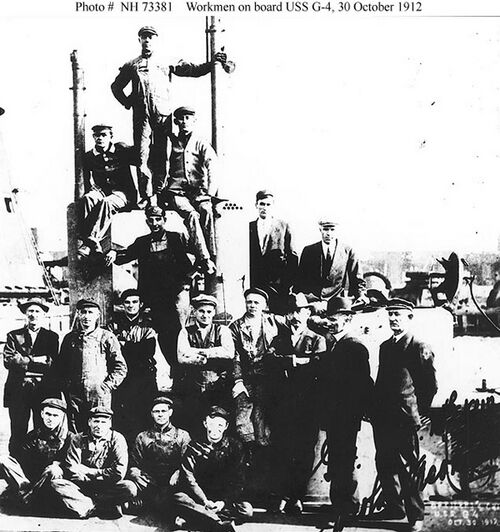
Photo NH 73381 courtesy NHHC.
-
Ship's officers and crew posed on deck, 1917. She was then operating out of Submarine Base New London, CT. The two officers (4th & 5th from left, front row) are Lieutenant (Junior Grade) Paul F. Foster (Commanding Officer) and Lieutenant (Junior Grade) William F. Callaway (Executive Officer). National Archives photo.
-
A G-4 crewman whose name has unfortunately been lost to the ages. He is in his dress blues, wearing the traditional "flat hat" with the G-4 name on it. The rate insignia on his left arm is unclear, but it may be for a Machinist Mate or Motor Machinist Mate 1st Class.
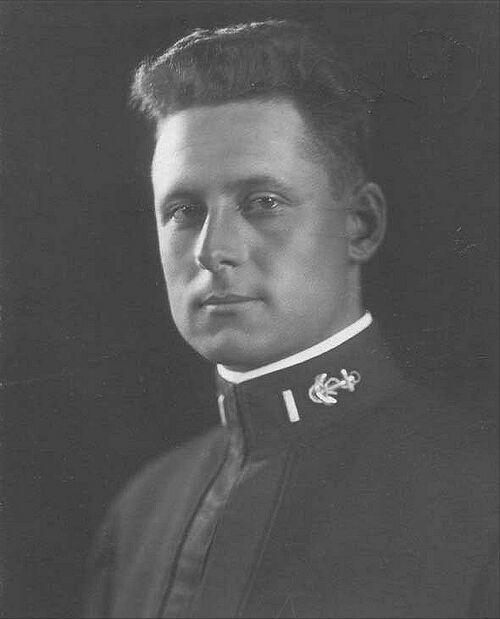
After submarine instruction on board the auxiliary cruiser USS Prairie, he reported on board the G-4. In March 1915, Foster was promoted to Lieutenant Junior Grade and, in early 1916, was given command of G-4.
Relocating to Ireland in December 1917, he was assigned to the submarine tender USS Bushnell (Submarine Tender No. 2) in Bantry Bay, Ireland. Foster was temporarily promoted to Lieutenant in May 1918. While serving in Irish waters, he took command of the submarine L-2 (Submarine No 41). Lieutenant Foster was awarded the Distinguished Service Medal for his role in the sinking of the German submarine UB-65 off the Irish coast on 10 July 1918.
National Archives photo.
-
Photographed on board the submarine G-4, commanding officer Lieutenant (Junior Grade) Paul F. Foster, circa 1915-1916. G-4 looks to be a wet boat on the surface.
-
G-4's officers standing beside their submarine, at Submarine Base New London, CT. in 1917. They are Lieutenant (Junior Grade) William F. Callaway (Executive Officer), at left, and Lieutenant (Junior Grade) Paul F. Foster (Commanding Officer).
National Archives photos.
Page created by:
David Johnston & Ric Hedman
1999 - 2023
PigBoats.COM©
Mountlake Terrace, WA
Norfolk, VA
webmaster at pigboats dot com
